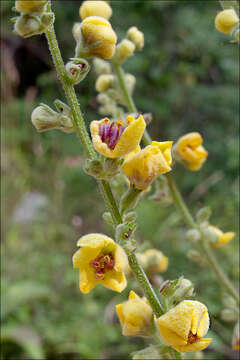Verbascum-chaixii_3

Description:
Verbascum chaixii s.lat. Vill.Chaix's Mulleins, DE: Chaix' Koenigskertze (ref.: 2), sterreich-Koenigskertze (ref.: 3), CR: avstrijska divizmaSlo.: Chaixov lunik / avstrijski lunikDat.: June 28. 2015Lat.: 45.09907 Long.: 14.46990Code: Bot_894/2015_IMG8704Picture file names: from Verbascum-chaixii_raw_1 to Verbascum-chaixii_raw_7.Habitat: Dirt road side, semi-ruderal place, small open place among bushes and low trees, calcareous ground, almost flat terrain, half sunny and dry place; near sea shore; exposed to direct rain, average precipitations 1.000 - 1.200 mm/year, average temperature 13-15 deg C, elevation 8 m (25 feet), Mediterranean phytogeographical region. Substratum: sandy soil.Place: West island Krk, near boat anchorage of the village Poljice, Adriatic Sea, Kvarner bay, Croatia EC. Comment: Genus Verbascum is quite difficult for proper determination. It is large, complex and hybrid plants are common. In addition, authors have different approaches to its taxonomy. This situation manifests also in the determination difficulties of the plants photographed. Nevertheless, I am almost certain that they belong to the group Verbascum chaixii s.lat. because of stalked, oval-oblong toothed basal leaves, proper length of flower stalks and equally long stamens with violet hairy filaments. Also habitat supports this assumption. This plant group is widely distributed and grows in the Alps (excluding northern regions) and other European mountains and lowlands including Balkan Peninsula (Ref.: 2). In the literature two subspecies are described: Verbascum chaixii ssp. chaixii and Verbascum chaixii ssp. austriacum. Some authors treat the latter on species level as Verbascum austriacum (Refs.: 1 and 4). With some exceptions the traits of the plants found correspond well to Verbascum chaixii ssp. chaixii. Particularly slightly lobed basal part of (some) ground leaves is an important distinguishing trait between both subspecies (Ref.: 3 and 1). Alternative Verbascum chaixii ssp. austriacum should have uniformly shaped leaves without any lobes. Contrary to this, the shape of basal leaf teeth (rounded) corresponds better to Verbascum chaixii ssp. austriacum. But, cross-section through the branches of inflorescence is not round, as it should be for Verbascum chaixii ssp. austriacum (Ref.: 4) but it is distinctly angulate. Confuses also the fact that Ref.: 5. (refers to whole Mediterranean region, which includes island Krk) lists only Verbascum chaixii ssp. chaixii (syn.: Verbascum chaixii s.str.), while Ref.: 4. (refers to territory of Croatia, which also includes island Krk) lists only Verbascum austriacum (syn.: Verbascum chaixii ssp. austriacum). Flora Croatica Database (Ref.: 6) shows no observations of either of both subspecies. Anyway, it seems that these plants are somewhere in-between both alternative subspecies. Such plants are mentioned also in Ref.: 3 and grow in South Tyrol region in Austria. Five or six plants were growing at the place where I found them.Ref.:(1) A.Martini et all., Mala Flora Slovenije, Tehnina Zaloba Slovenije (2007) (in Slovenian), p 549. (2) D. Aeschimann, K. Lauber, D.M. Moser, J.P. Theurillat, Flora Alpina, Vol. 2., Haupt (2004), p 194.(3) M.A. Fischer, W. Adler, K. Oswald, Exkursionsflora sterreich Liechtenstein, Sdtirol, LO Landesmuseen, Linz, Austria (2005), p 722.(4) R. Domac, Flora Hrvatske, Prirunik za odreivanje bilja (Flora of Croatia, Manual for plant determination), Manualia Universitatis Studiorum Zagrabiensis, kolska knjiga (2002), p 271.(5) M. Blamey, C. Grey-Wilson, Wild Flowers of the Mediterranean, A & C Black, London (2004), p409.(6) Flora Croatica Database, Department of Botany, Faculty of Science, FER-ZRP, University of Zagreb
Included On The Following Pages:
- Life (creatures)
- Cellular (cellular organisms)
- Eukaryota (eukaryotes)
- Archaeplastida (plants)
- Chloroplastida (green plants)
- Streptophyta
- Embryophytes
- Tracheophyta (ferns)
- Spermatophytes (seed plants)
- Angiosperms (Dicotyledons)
- Eudicots
- Superasterids
- Asterids
- Lamiales ("An Order: Mints, Vervains, Snapdragons, Etc.")
- Scrophulariaceae (figwort family)
- Verbascum (mullein)
- Verbascum chaixii (nettle-leaf mullein)
This image is not featured in any collections.
Source Information
- license
- cc-by-nc-sa
- copyright
- Amadej Trnkoczy
- photographer
- Amadej Trnkoczy
- original
- original media file
- visit source
- partner site
- Flickr Group
- ID


